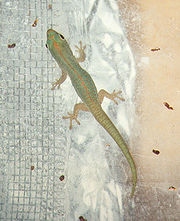
Phelsuma v-nigra v-nigra
Encyclopedia
Phelsuma v-nigra v-nigra Boettger
, 1913 (syn.Phelsuma v-nigra Kluge, 1993) is a small diurnal
subspecies
of gecko
s. It lives in the Comoros
and typically inhabits trees and bushes. Phelsuma v-nigra v-nigra feeds on insects and nectar.

Oskar Boettger
Oskar Boettger was a German zoologist who was a native of Frankfurt am Main. He was an uncle of the noted malacologist Caesar Rudolf Boettger ....
, 1913 (syn.Phelsuma v-nigra Kluge, 1993) is a small diurnal
Diurnal animal
Diurnality is a plant or animal behavior characterized by activity during the day and sleeping at night.-In animals:Animals that are not diurnal might be nocturnal or crepuscular . Many animal species are diurnal, including many mammals, insects, reptiles and birds...
subspecies
Subspecies
Subspecies in biological classification, is either a taxonomic rank subordinate to species, ora taxonomic unit in that rank . A subspecies cannot be recognized in isolation: a species will either be recognized as having no subspecies at all or two or more, never just one...
of gecko
Gecko
Geckos are lizards belonging to the infraorder Gekkota, found in warm climates throughout the world. They range from 1.6 cm to 60 cm....
s. It lives in the Comoros
Comoros
The Comoros , officially the Union of the Comoros is an archipelago island nation in the Indian Ocean, located off the eastern coast of Africa, on the northern end of the Mozambique Channel, between northeastern Mozambique and northwestern Madagascar...
and typically inhabits trees and bushes. Phelsuma v-nigra v-nigra feeds on insects and nectar.
Description
This lizard belongs to the smallest day geckos. It can reach a maximum length of approximately 10 cm. The body colour is bright green, which may have a blue hue. There is a red v-shaped stripe on the snout and two red bars between the eyes. On the back there often are a number of small red-brick coloured dots. The typical v-shaped marking on the throat may not be present in adults. The ventral side is yellow.Diet
These day geckos feed on various insects and other invertebrates. They also like to lick soft, sweet fruit, pollen and nectar.

